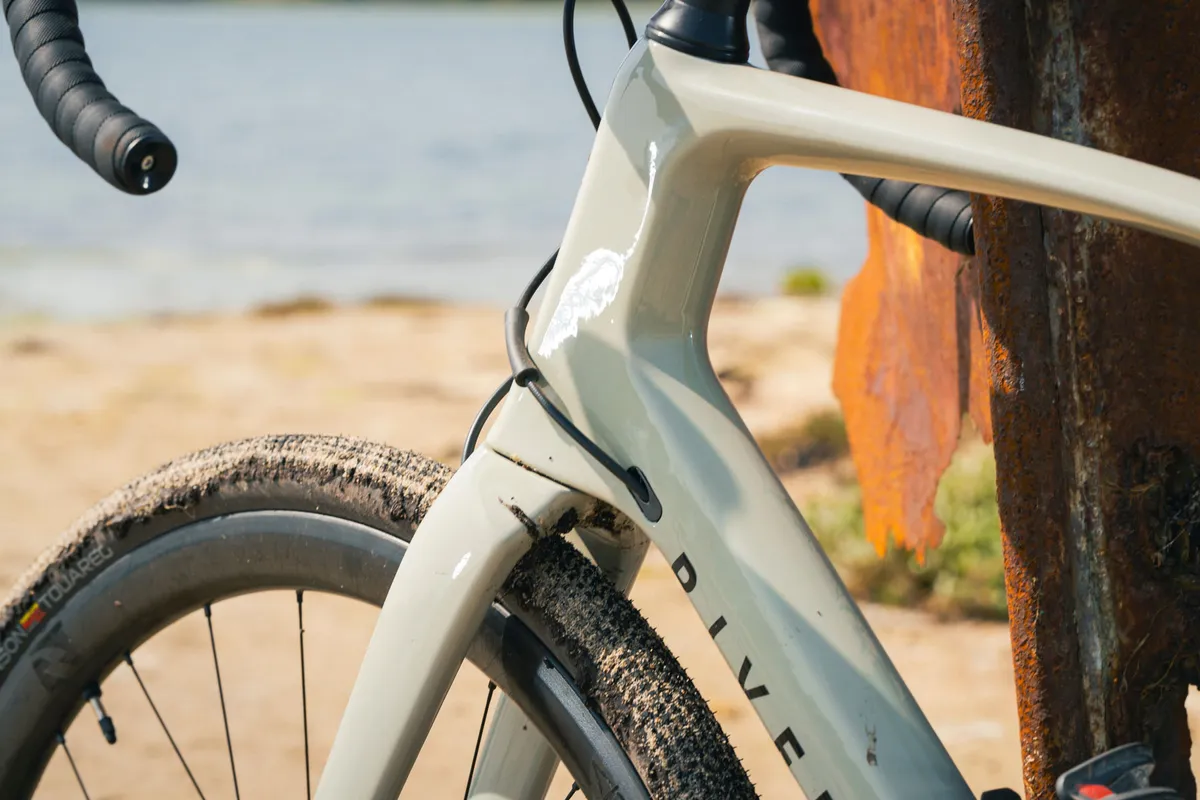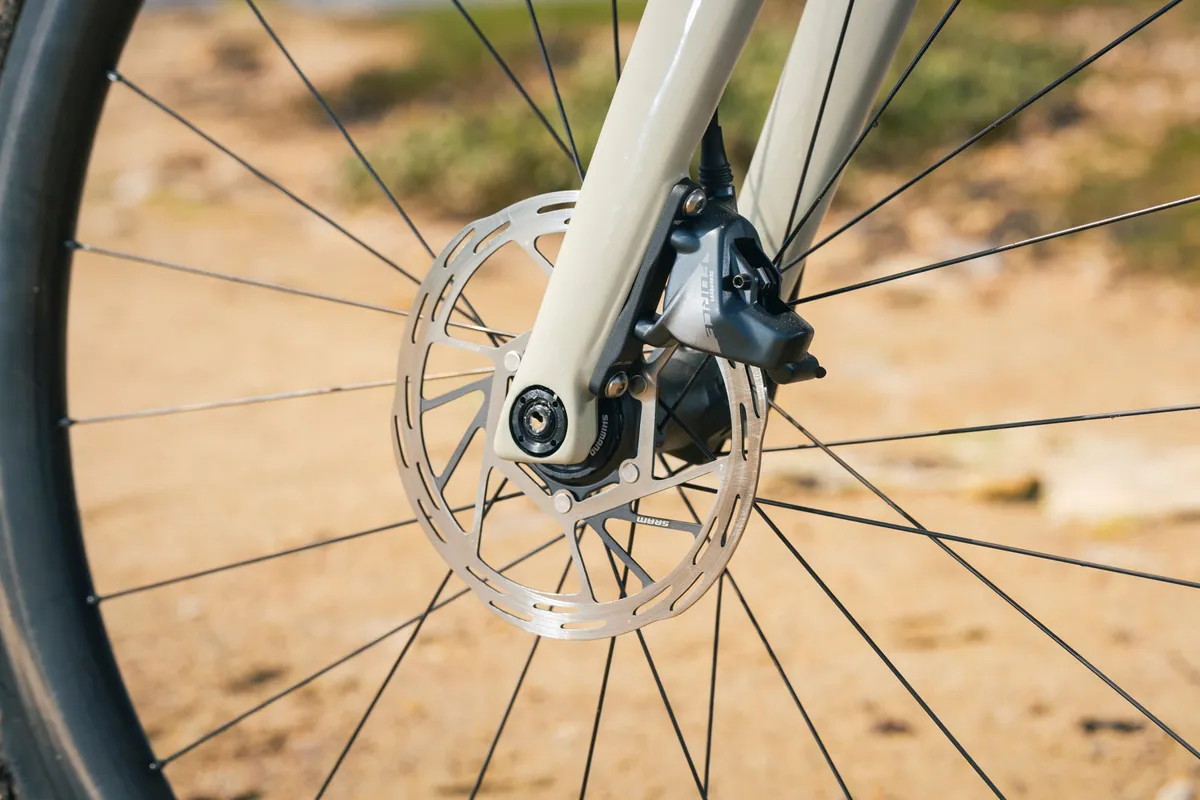Riverside is Decathlon’s gravel-specific companion to Van Rysel and the Riverside GCR bears UCI certification, making it eligible for gravel racing at the highest level.
In testing, the Riverside GCR has proven quick on tarmac and lighter gravel.
Without question, it’s great value to boot, but it can become undone when the going gets really rough and technical.
The GCR Force is a gravel bike best reserved for mixed duties on better-condition surfaces.
Riverside GCR Force AXS XPLR frameset details

The carbon frame and fork certainly look the part with the on-trend muted 'clay' colourway and understated graphics.
Underneath the paint hides a carbon construction that blends standard-modulus carbon (for a mix of stiffness, compliance and strength) with high-modulus layers within the bottom bracket shell and head tube to increase stiffness where Decathlon believes it matters.
With a claimed frame weight of 1,058g (in a size medium) and fork weight of 442g, it’s competitively light, coming in a few grams lighter than the Cervélo Áspero’s frame (1,141g) and fork (452g) in the same nominal size.

Compared to the 2024 Gravel Bike of the Year category winner, the GT Grade Carbon, it’s a little heavier (980g frame weight and 432g fork, in a size large).
The frame uses dropped stays and a round 27.2mm diameter seatpost. This opens up an easy upgrade pathway to a carbon post (a simple alloy post is fitted here), or potentially a switch to a gravel dropper post.
The simple external cable routing makes cockpit upgrades a breeze. The standard tapered steerer means upgrading to a gravel suspension fork could also be an option.
Like the Áspero, the GCR certainly looks to be aimed more at racers and day riders rather than multi-day eventers and bikepackers. It has minimal fittings of two bottle cages, though the down tube has three bosses for two options on bottle position.

The fork misses cargo mounts and there’s no provision for gravel mudguards either. The seat tube has a mounting point for a front derailleur, so it could be run with a 2x drivetrain.
The GCR has clearance for 42mm tyres, less than the Áspero’s 46mm or the GT Grade Carbon, at 50mm.
A press-fit bottom bracket finishes off the GCR’s frame details.
Riverside GCR Force AXS XPLR geometry

The geometry is certainly aimed at gravel racing more than rugged technical trail riding.
My size-large test bike has a low 582.5mm stack, though its 387.5mm reach is on the shorter side – 10mm less than the Áspero and 37.5mm less than the progressive GT Grade.
427mm-long chainstays provide the 42mm tyre clearance and a long wheelbase (1,027.4mm) is intended to promote ride stability.
The combination of a 72-degree head angle and 72.5-degree seat tube angle certainly put the GCR firmly in the road-derived gravel camp rather than the latest trend for mountain-bike inspired progressive geometry on bikes such as the Santa Cruz Stigmata or the aforementioned GT Grade Carbon.
| | S | M | L | XL |
|---|---|---|---|---|
| Seat tube angle (degrees) | 73 | 72.5 | 72.5 | 72.5 |
| Head tube angle (degrees) | 71 | 71.5 | 72 | 72 |
| Chainstay (mm) | 427 | 427 | 427 | 427 |
| Seat tube (mm) | 473 | 500 | 528 | 555 |
| Top tube (mm) | 529 | 550 | 571 | 592 |
| Head tube (mm) | 119 | 139 | 169 | 199 |
| Wheelbase (mm) | 994.2 | 1011.1 | 1027.4 | 1048.7 |
| Stack (mm) | 531 | 552 | 582.5 | 611 |
| Reach (mm) | 361.5 | 376 | 387.5 | 399 |
Riverside GCR Force AXS XPLR build

A price of £4,000 for a bike fitted with a SRAM Force AXS XPLR groupset and Reynolds ATR carbon gravel wheels is impressive on paper.
This is a good chunk cheaper than either the Áspero or Argon 18 Dark Matter I tested alongside it. Not even Canyon can match this sort of value, with its equivalent Grail CF SLX 8 AXS coming in at £5,099 with Force AXS and a Zipp 303 wheelset (the two brands have similar – but not identical – direct sales business models).
That said, looking a little deeper into the specification you can see how the low price might have been achieved.

The bar, stem and seatpost are own-branded alloy items and the Force AXS XPLR groupset isn’t the improved version launched last year as found on the Argon 18 – it’s the previous generation.
That’s not the deal breaker it might appear, though. Aside from redesigned shifters, reduced hood size and a redesigned chainset – all of which were welcome improvements – little else changed beyond the sharper cosmetics.
The Reynolds ATR wheels have a 40mm-deep rim with a 23mm-wide internal measure (my colleague Ashley Quinlan has reviewed the similar ATRx wheelset, which is one tier higher in the range).
The pawl-based freehub has 36 points of engagement for a quick 10-degree engagement angle, while, the build is solid stuff, with Sapim Sprint spokes and corrosion-resistant brass nipples.
The claimed weight of 1,685g, however, doesn’t exactly put them in the same lightweight camp as either the Reserve 40/44 combination found on the Cervélo Áspero (1,425g) or the Hunt Limitless gravel wheels on the Argon 18 Dark Matter (1,548g).

Decathlon provides the Riverside with 700 x 40c Hutchinson Touareg tubeless tyres seated on the rims, but without sealant. This is a smart move, given sealant can dry in the time taken from assembly to sale, and Decathlon includes a bottle of sealant for each wheel.
The Fizik Argo Terra is a great saddle (assuming it fits you, of course), cushioned enough for rough gravel riding, yet sleek enough to not be intrusive. The X5 version fitted here is the base-model ‘cro-mo’ alloy-railed version.
On the scales, my size-large test bike comes in at a not shabby 8.6kg.
Riverside GCR Force AXS XPLR ride impressions

The GCR is a very capable gravel race bike that's well suited to going fast off-road.
The Touareg tyres bring about good grip in the dry, with the tightly spaced gridded tread not feeling squirmy or sluggish on tarmac either. They pack with mud quickly in softer conditions, but I found they clear quickly too.
The bike’s handling is nicely neutral – it feels like a good endurance bike on the road, while off-road it holds no surprises with its steady steering responses. That’s a good thing when traversing bumpy double-track trails and large loose gravel sections.

On smoother surfaces, the GCR is quick, it responds quickly, and the unobtrusive Hutchinson rubber doesn’t slow progress.
The XPLR gearing, with a top-end 44/10T gear, is plenty fast enough for fast off-road descents, while at the other end the 44/44 combination brings a 1:1 ratio, which will see you pedalling up the steepest gradients when some around you might be hiking.
The Force AXS XPLR groupset performs well, with slick positive-feeling shifts, powerful braking and brilliant chain control thanks to the orbit fluid damper-equipped rear derailleur (albeit the latest Force AXS groupset is an improvement in some areas, as I’ve mentioned).

Among my riding companions, there are a few who prefer the older-shape hoods on this version of Force (with their larger pommels offering a more substantial hold) when riding rougher off-road terrain. If you’re one of those people, the opportunity to buy a bike with it installed may be welcome.
It’s only when the going gets both fast and rough that the Riverside becomes somewhat undone.
At the back, it manages fine– the suitable saddle, compliance offered by the tyres and some give in the low-slung seatstays reduce wearing chatter well. A carbon seatpost might offer more compliance again, but the alloy post doesn’t ruin the overall experience here.

Up front, though, the combination of the stiff-feeling alloy bar, chunky oversized fork and substantial head tube make for a chattery, very rigid-feeling front end that numbed my fingertips through the pressure exerted.
It also had me, on more than one occasion, having to back off the pace to get the GCR feeling as though it was back under my control, as opposed to darting about.
It’s not a simple cure, because Decathlon has wrapped the bar in quality cushioned tape. You could look to upgrade the bar to carbon that’s better at absorbing vibrations, though I think I’d go further and install something like a Redshift Shockstop stem, or even a gravel suspension fork.
Riverside GCR Force AXS XPLR bottom line

The Riverside GCR is undoubtedly a great-value bike, and on mixed surfaces it delivers an impressive turn of speed.
When things get rougher, however, it suffers from fatiguing vibrations, and handling-compromising chatter and rigidity at the front end.
If your gravel riding goals are more wide open unmetalled surfaces, forest fire roads, and smoother double track, the GCR should be all the bike you need. However, venture onto anything tougher or more technical and it becomes a bit of a handful.
Product
| Brand | Riverside |
| Price | €3900.00, £4000.00, $5700.00 |
| Weight | 8.60kg |
Features
| Fork | Carbon |
| Stem | Ergo alloy 100mm |
| Chain | Force 12 S |
| Frame | Carbon |
| Tyres | Hutchinson Touareg tubeless 40mm |
| Brakes | SRAM Force Hydraulic, 160mm rotors |
| Cranks | SRAM Force DUB 44t |
| Saddle | FiZik Argo Terra X5 |
| Wheels | Reynolds ATR Carbon |
| Shifter | SRAM Force AXS |
| Cassette | SRAM Force 10-44 |
| Seatpost | Alloy 27.2mm |
| Handlebar | Ergo alloy 420mm |
| Bottom bracket | SRAM DUB |
| Available sizes | S, M, L, XL |
| Rear derailleur | SRAM Force AXS XPLR |
